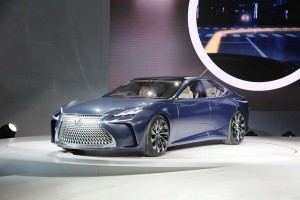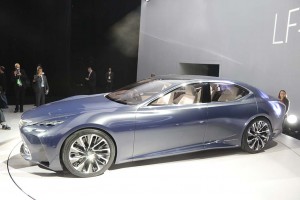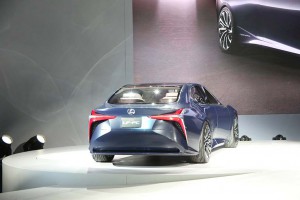With tough new emissions and fuel economy standards looming in front of them, automotive manufacturers are struggling to find ways to boost the efficiency of their vehicles. But now all of them are convinced that batteries are the answer. Toyota, for example, is hedging its bets with hydrogen fuel-cell vehicles.
It recently put its first, the Mirai, on sale in Japan and the U.S., and during a news conference at the North American International Auto Show, the maker’s upscale Lexus brand showed its own take on hydrogen power with the American debut of the LF-FC Concept.
“It is the luxury fuel-cell concept of the future,” explained Akio Toyoda, the president of Toyota Motor Co., and the grandson of the automaker’s founder.
First shown at the Tokyo Motor Show last October, the Lexus LF-FC reveals a few subtle similarities to the new Toyota Mirai, primarily in the form of the large, jet-like air intakes on other side of the familiar Lexus spindle grille.
Some have suggested that the coupe-like sedan’s design could reappear in the form of the brand’s next-generation LS flagship. While that’s possible, it’s also quite clear that Toyoda would like to see the Lexus brand add its own, more sporty fuel-cell vehicle.
“With this car,” he said “we want to achieve zero emissions. In its current form, the fuel-cell stack under the concept car’s skin is similar to the technology in use on the Mirai. The Toyota model produces about 152 horsepower and 247 pound-feet of torque. That’s enough to launch the Mirai from 0 to 60 in 9.0 seconds, with a top speed of 111 mph.
(Lexus pushes passion and performance with LC 500. For more, Click Here.)
A production version of the LF-FC would likely offer better performance than the Mirai, according to several Lexus insiders.
In concept form, the luxury fuel-cell vehicle delivers power to both front and rear wheels through separate electric motors, creating what is sometimes called a through-the-road all-wheel-drive system, in this case adding torque vectoring to improve cornering.
Hydrogen technology has several advantages over batteries. The Mirai delivers about 300 miles range on a tank of the car and it can refill in just four to five minutes – roughly what it takes to pump a tankful of gasoline – if you can find a source for hydrogen.
(Click Here for details about the new Porsche 911 Turbo, Turbo S.)
That’s the big drawback. For the moment, there are only a handful of pumps in the U.S., most of them in Southern California. But lawmakers have set aside funding for a broader network across the Golden State, and several other states are considering similar moves. Germany and Japan are also trying to expand their hydrogen infrastructures.
Along with the Mirai, Hyundai now sells a fuel-cell version of its Tucson SUV, and Honda plans to launch its Clarity hydrogen car later this year. Still other entrants could follow.
During its own news conference at the North American International Auto Show, Audi unveiled its own hydrogen concept, the h-tron Quattro. Describing it as a “serious” effort, Audi AG Chief Executive Rupert Stadler said he’d like to get the h-tron into production by decade’s end – but he said the maker will first need to be convinced there’ll be a big enough infrastructure to support the demand needed to justify the expense.
(To see more about the Infiniti Q60 sports coupe, Click Here.)
For his part, Toyota President Toyoda is looking at a similar timetable, hoping to put the LF-FC on the road by 2020.




No, “all of them are NOT convinced that batteries are the way”. Many companies are working diligently on hydrogen fuel cells and they are more practical and viable than battery power. The hydrogen suppliers need to start building a refueling network now as the fuel cells cars will be coming fast and furious very soon.